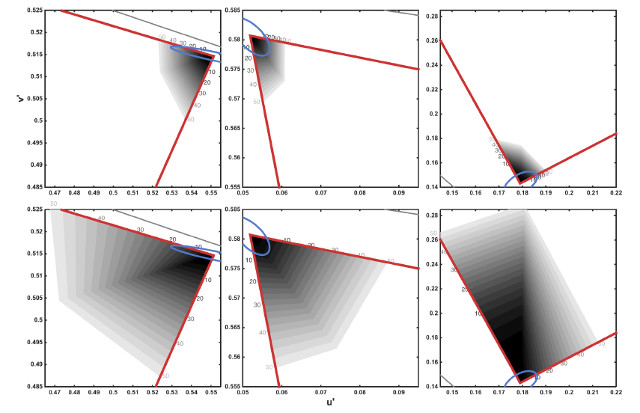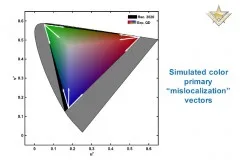At last year’s SMPTE conference, James Hillis from 3M described some tests they had done to try to determine how far the 2020 color primaries can move and still be indistinguishable from a true 2020 display. This year, he provides some updates to the work they have continued. The goal is to try to define the tolerance for the 2020 primaries so these can be standardized (none exist yet) and displays that are 2020-compliant can be produced and marketed. 3M has a keen interest in this as they make the quantum dot films used in some TV that can achieve close to the 2020 color gamut.
The results consist of a number of simulations where the DeltaE2000 parameter was used to determine when a person might not see a difference between two colors. Colors were compared side-by-side and sequentially (the side-by-side provides better results as color memory is not good in humans). Color changes were made going from the RGB primaries toward white and from each primary toward the other two primaries (figure).

The results for red, green and blue primaries are summarized below for the side-by-side (bottom) and sequential (top) testing. This is based upon the results of 13 participants looking at photographs, not color patches, so a more real world application. A quantum dot TV was used for the testing.

The way to interpret these results is to look at the contours as likelihood of seeing a difference. In other words, a 50% detection rate means that 50% of a randomly selected group of people will see a color difference if the shifted color is in the 50% or smaller region.
3M thinks this data will help to quantify what the tolerance should be for a 2020 display. But it can help to create new definitions as well. For example, they suggested the data allows one to say, “This display is indistinguishable from an ideal Rec. 2020 display for x% of content and viewer combinations.” But to implement this would require additional testing with more people and more pictures.
Alternatively, the industry could agree upon an acceptable detection rate, say 25%, and use that to specify the range of primaries for the display. Maybe it might be OK to make the 50% detection rate “compliant”, a 30% detection rate “very compliant” and a 10% detection rate as “extremely compliant”, or some such marketing terms.
3M hopes to continue experiments and industry dialog to develop a standardized method for determining 2020 compliance.
Analyst Comment
This is an important point for the market. In the monitor world, most monitors, according to those who test them, comply with sRGB, or are very close. However, because there is not a practical tolerance on the sRGB gamut and products do have small variations, brands are very reluctant to certify them as meeting sRGB unless they can do so relatively easily. This means that the specification, which should be an important part of buying almost any PC display, simply doesn’t get discussed very often. (BR)

